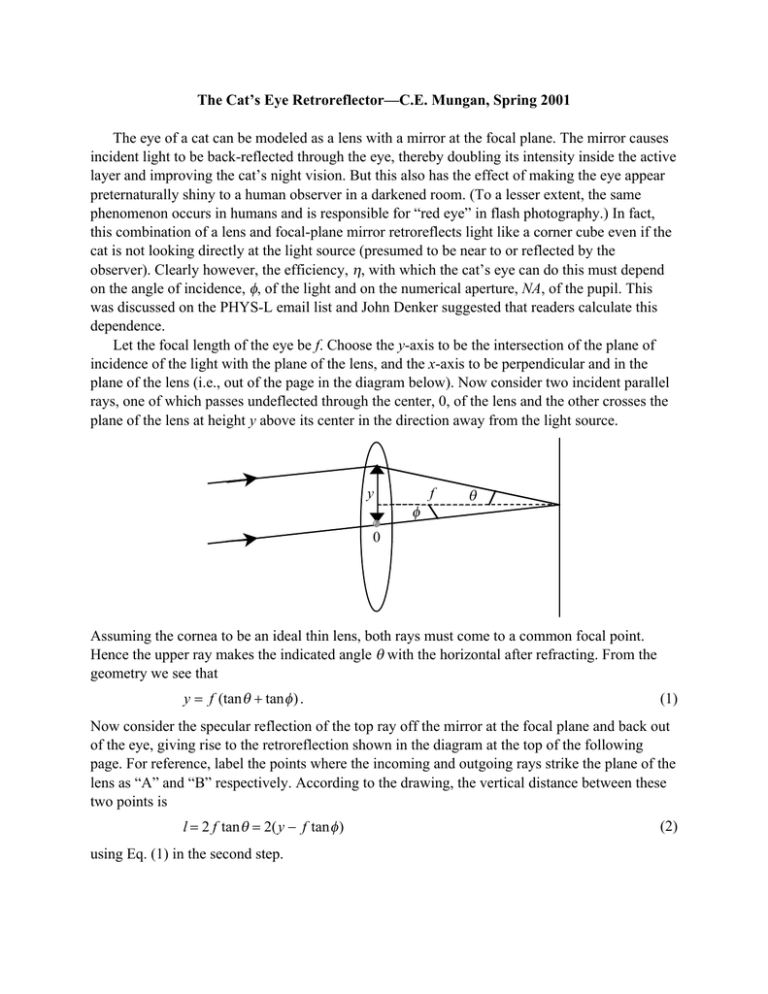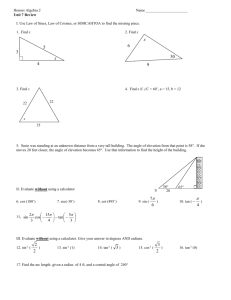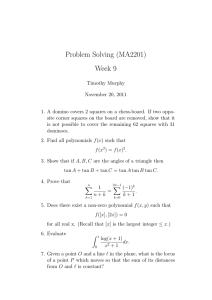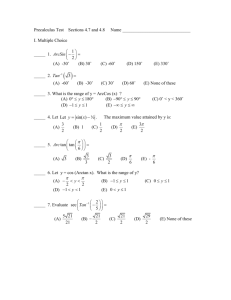The Cat’s Eye Retroreflector—C.E. Mungan, Spring 2001
advertisement

The Cat’s Eye Retroreflector—C.E. Mungan, Spring 2001 The eye of a cat can be modeled as a lens with a mirror at the focal plane. The mirror causes incident light to be back-reflected through the eye, thereby doubling its intensity inside the active layer and improving the cat’s night vision. But this also has the effect of making the eye appear preternaturally shiny to a human observer in a darkened room. (To a lesser extent, the same phenomenon occurs in humans and is responsible for “red eye” in flash photography.) In fact, this combination of a lens and focal-plane mirror retroreflects light like a corner cube even if the cat is not looking directly at the light source (presumed to be near to or reflected by the observer). Clearly however, the efficiency, η, with which the cat’s eye can do this must depend on the angle of incidence, φ, of the light and on the numerical aperture, NA, of the pupil. This was discussed on the PHYS-L email list and John Denker suggested that readers calculate this dependence. Let the focal length of the eye be f. Choose the y-axis to be the intersection of the plane of incidence of the light with the plane of the lens, and the x-axis to be perpendicular and in the plane of the lens (i.e., out of the page in the diagram below). Now consider two incident parallel rays, one of which passes undeflected through the center, 0, of the lens and the other crosses the plane of the lens at height y above its center in the direction away from the light source. y φ f θ 0 Assuming the cornea to be an ideal thin lens, both rays must come to a common focal point. Hence the upper ray makes the indicated angle θ with the horizontal after refracting. From the geometry we see that y = f (tan θ + tan φ ) . (1) Now consider the specular reflection of the top ray off the mirror at the focal plane and back out of the eye, giving rise to the retroreflection shown in the diagram at the top of the following page. For reference, label the points where the incoming and outgoing rays strike the plane of the lens as “A” and “B” respectively. According to the drawing, the vertical distance between these two points is l = 2 f tan θ = 2( y − f tan φ ) using Eq. (1) in the second step. (2) A θ θ f l B Next let’s assume for simplicity that the pupil is round with radius R. (This is actually not true for a cat, so you may wish to imagine some other animal instead.) Rotate the preceding diagram 90˚ so that you are looking at the pupil head on. Suppose point A lies on the edge of the iris at coordinates ( x, y ) . Then point B must have coordinates (− x, − l + y ) . Reflecting this across the y-axis lands us at point C on the diagram below, directly below point A. y A R l D 0 x B C 2 f tan φ The overall enscribing circle in this figure is the pupil. Points B and C lie on a curve which according to Eq. (2) is a portion of a circle of the same radius as the pupil but displaced upward by 2 f tan φ . Any light incident within the intersection of these two circles (i.e., in the approximately oval-shaped region) will be retroreflected back out of the eye; in contrast, light falling within the lower crescent-shaped area will strike the backside of the iris just above the pupil. It is easy to find this retroreflecting area A by integrating, x0 x0 0 0 A(φ ) = 2 ∫ l dx = 4 ∫ ( ) R 2 − x 2 − f tan φ dx (3) using Eq. (2), where the coordinates of the point D at which the two circles intersect is ( x 0 , y 0 ) . Solve the equations of the two circles simultaneously to find this point, x 02 + y 02 = R 2 and x 02 + ( y 0 − 2 f tan φ ) 2 = R 2 ⇒ y 0 = f tan φ . (4) Next, the integral in Eq. (3) can be done by introducing the conventional plane polar angle. The result is 2 A(φ ) = 1 − (ψ + cosψ sinψ ) , A0 π (5) where A0 ≡ πR 2 is the area of the pupil and where the sine of the polar angle corresponding to point D is sinψ ≡ y0 f 2 tan φ . = tan φ = R R NA (6) Here I introduced the numerical aperture of the pupil, NA ≡ 2 R / f (which is the reciprocal of its f-number). Finally we can calculate the retroreflection efficiency by projecting the area on the lens into the direction of incidence, η= A cosφ , A0 (7) efficiency normalized to 100% if the cat is looking straight at you (i.e., φ = 0˚ ). Equation (7) is plotted below for two different values of the numerical aperture. 1 0.9 0.8 0.7 0.6 0.5 0.4 0.3 0.2 0.1 0 NA = 1 NA = 2 0 5 10 15 20 25 30 35 40 45 angle of incidence (degrees) The efficiency falls to zero at the angle φ max = tan −1 ( NA / 2) = tan −1 ( R / f ) . This is easy to understand by drawing a quick sketch similar to the first figure in this paper, but with the upper ray grazing the topmost edge of the pupil and then striking the retina perpendicularly. Expanding Eqs. (5)–(7) to the lowest nonzero order in φ gives η ≈ 1− φ NA −1. 22.5˚ (8) In fact, this is a reasonably good fit to the above graphs for all φ, and not just for small values. It thus enables us to quickly estimate how shiny the eyes will appear for different tilt angles of the animal’s head and dark adaptation of its eyes.







